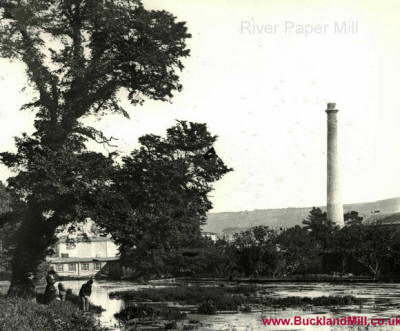River Paper Mill
C P Davies, during the course of his research work in connection with old water mills on the Dour, found evidence of industry in the form of corn mills as far back as 1227 in the area of River. He found the first mention of a paper mill at River in deeds preserved in the county Archive Office which record in 1669 the sale by John Smith, mariner, to Susanna Williams of the "moytie..... in the parish or River". There are three further deeds relating to the ownership of property by members of the Hatton family, one of whom, Edward, was a millwright.
In 1704 the property was sold to Peatly Sturgis who bequeathed it to his wife Katherine. She, in her will dated 1717, left a legacy of Five pounds to her tenant John Walten, "living at the paper mill in River" and bequeathed the property to her cousin Katherine Dawkes. That John Walters was the papermaker and not just living there is confirmed by an entry in "The Apprentices of Great Britain" to the effect that John Walters of River, papermaker, took an apprentice Thomas Langley in 1719. A further mention of the industry in River comes from "Reads Weekly Journal or British Gazetteer" of 26th May 1755 which mentions one "Thomas Bannister, papermaker of River".
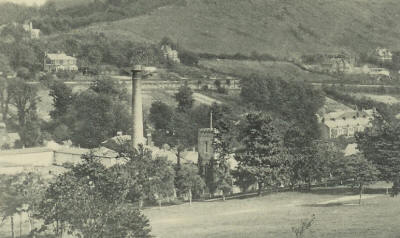
Mill chimney in the distance
In the early 18th. century papermaking was mainly a cottage industry and so we find that John Walters both lived and carried out his craft at the mill. There is further evidence of this mode of life practiced by papermakers at both Buckland Mill end at Horne Street Mill, Cheriton, to which reference will be made later.
In 1756 the mill was sold to Thomas Radford, "all the messuage mill house and water mill, late and now used for a paper will and commonly called River Mill".
A.H. Shorter records that Thomas Radford was making paper at Boxley in Kent between 1678 and 1689 and further that his first known association with River was in 1752, four years before it is known that he bought the mill. Radford died in 1760 and left the "mill ground and house" to his wife Sarah.
The wording of the will suggests that Radford had a house apart from the mill, maybe because he had prospered in his trade. Sarah’s son, Thomas, ran the mill for some years for his mother and in 1780 William Phipps was her tenant.
At about the same time she appears to have sold the mill to William Phipps and John Aldridge who, 1782, became bankrupt. The property was bought by Israel Claringbould who in turn sold it to Thomas Boykett, at the same time reserving the power of redemption. At this point matters become somewhat confused although certain known facts act as straws in the wind.
William Phipps married twice, his second marriage being to Ann Claringbould, the daughter of Israel Claringbould. By 1792 William Phipps had prospered, he had a connection with lower Buckland Paper Mill and had erected, in 1790, a paper mill at Crabble and he was once more the occupier of the River Mill.
By 1800 he was able to pay £2,100 to Peter Fector and James Peter Fector Dover Bankers, though Claringbould to become the owner of River Mill
William Phipps died in 1820 leaving the business then known as William Phipps & Sons, to his sons Christopher and John. By 1839 the business belonged solely to Christopher. It is believed that John had joined his uncle, William’s brother, John Phipps in his wholesale stationers business in London. During the joint ownership of the mill an 1821 a survey of the property described it as a two vat mill with drying lofts heated by steam pipes.
An area on the survey plan is shown as "Machine room and Vat room with drying loft over" so it may be assumed that a papermaking machine had been installed by 1821.
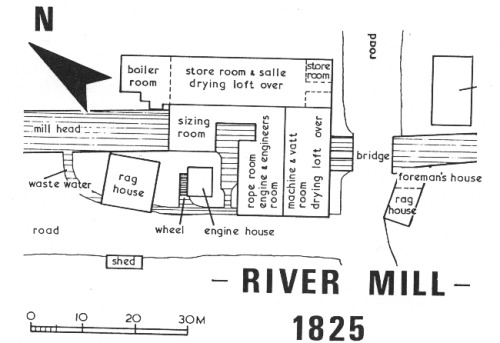
Christopher died in 1867 and the mill passed to his nephew, Filmer Phipps. By the terms of the will he had to make a large cash payment to another beneficiary and this may have been a contributing factor which caused him to mortgage both River and Crabble mills in 1871.
He became bankrupt in 1882 but the business continued under his management. Both mills were put up for sale in 1894 and the River mill again in 1908 when it fetched £2,100 and the Phipps house £600.
During the latter years the mill made cartridge paper for Eleys and Kynocks. The mill was finally closed down in 1918 and scrapped.
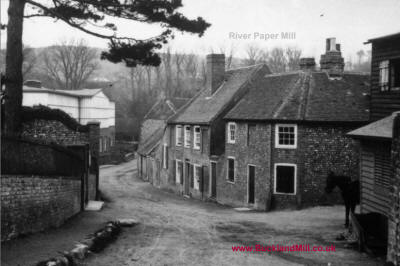
Looking down Minnis Lane towards the mill (on the left)
At the sale in 1894 the River Mill, Registered No 31, contained an area of "about 5 acres 3 roods and 39 poles" and consisted of an L shaped brick, flint and timber building, 122 feet by 31, feet and 80 feet by 50 feet 6 inches, of two floors containing on the upper floor drying rooms.
On the ground floor machine room and stuff room, "Sol" and finishing rooms with annexe at the end to form a guillotine cutting house. The Beater room was 93 feet by 34 feet, of brick and flint, boarded and felted roof.
The mill had four water wheels driving five beaters, two pumps, the machine and stuff chests. There was also an auxiliary water wheel to pump water for the house and drive revolving gear for the rag boiler. The mill was served by a Lancashire Boiler and had several other buildings.
The 52 inch papermaking machine had eight drying cylinders, eight screw presses, a vertical engine, a 6 H.P. horizontal engine on Loco type boiler and a compound condensing beam engine.
There were a total of nine beating and washing engines, one rag boiler and various other items of plant including a low pressure beam condensing engine and another horizontal steam engine.
Mr Phipp's house had five bedrooms on the upper floor, one with bath, five bedrooms of the first floor, a dressing room and bath room and good accommodation on the ground floor including a spacious wine cellar.
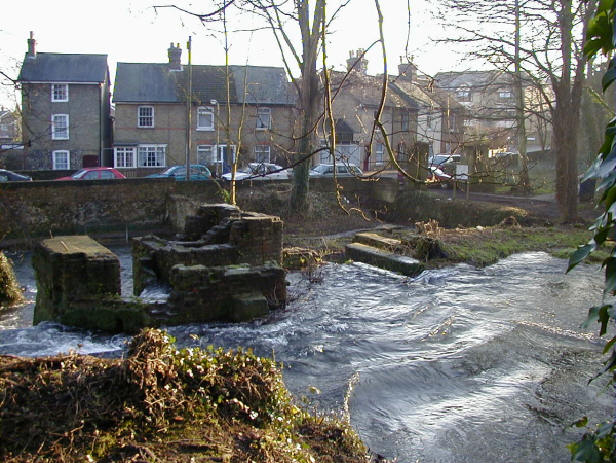
Where the mill was
